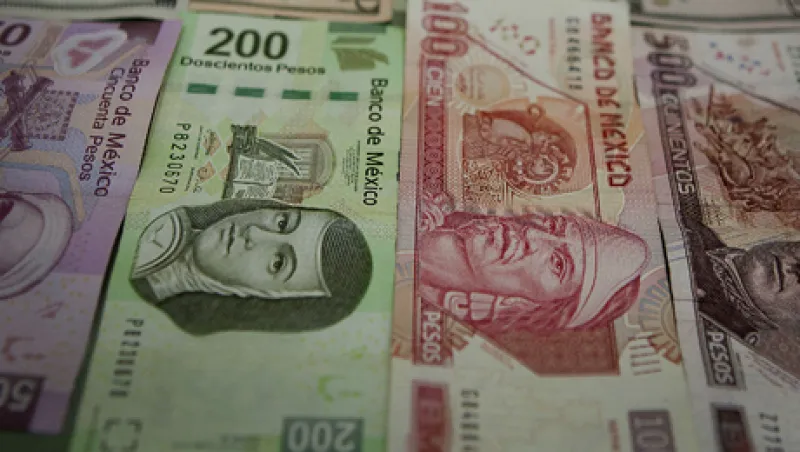Long derided as a symbol of instability, the Mexican peso is making a comeback as a popular international currency. The peso is now traded around the world as a proxy for the North American economy, and investor demand for it goes far beyond domestic economic considerations.
“More people internationally have exposure to the Mexican peso than ever before,” says Michael Woolfolk, a New York–based senior currency strategist at Bank of New York Mellon. “Mexico is becoming a Canada of the South rather than a key Latin American currency.”
Several things make the peso attractive. Its biggest draw is that it’s readily convertible, unlike many other emerging-markets currencies. Mexico’s investment-grade credit rating appeals to fund managers that are prohibited from investing in lower-grade debt. And investors can buy over-the-counter peso forwards that settle in pesos, whereas Chinese renminbi and South Korean won forwards are nondeliverable and settle in dollars. Under the Dodd-Frank Wall Street Reform and Consumer Protection Act, trading nondeliverable forwards will get much tougher because only certain dealers will be allowed to do so, and the peso will be even more desirable.
Another lure of the peso: Mexico doesn’t impose any capital controls. By contrast, the Brazilian government has tried to slow hot-money inflows by taxing incoming investments, a barrier that has dampened demand for the real. Mexican bonds trade as freely as the currency. “A lot of investors who want to express a view on emerging-markets debt are choosing the Mexican market to do that,” says Ilan Solot, an emerging-markets currency strategist at Brown Brothers Harriman & Co. in London.
With its benchmark overnight interest rate steady at 4.5 percent for the past two years, Solot says, Mexico presents a good opportunity for the carry trade, in which investors borrow low-yielding currencies like the U.S. dollar and buy higher-yielding debt of another country. Ten-year Mexican bonds now offer an interest rate of 5.8 percent.
All of this is a far cry from 1994, when the peso crashed after the Mexican government relaxed its fixed exchange rate system and investors stampeded for the exits. The U.S. led a $50 billion rescue package to support the government of then-President Ernesto Zedillo; this eventually stopped the currency run but left the peso’s reputation in tatters and the economy in a deep recession.
Now investors are cheering the recent election of Enrique Peña Nieto as Mexico’s new president. Peña Nieto’s Institutional Revolutionary Party promises sweeping economic reforms after he takes office in December, despite the party’s history of corruption and heavy state control during its 70 years in power up until 2000.
Vitali Meschoulam, head of emerging-markets foreign exchange and rates at Morgan Stanley in New York, says the peso has become a global currency because traders and investors can obtain prices on it 24 hours a day, even though the bulk of trading takes place when North American markets are open. “You can get prices during Asian hours, which is much more than you can with any other emerging-markets currency,” he says.
Another reason for global trade in the peso is that the currency is closely correlated with the Standard & Poor’s 500 Index, Meschoulam says. “When investors need to hedge some of the risk of emerging markets in their portfolio, instead of selling bonds, which can be a costly endeavor, they can go for one of the most liquid assets in emerging markets and short the peso,” he notes.
Mexico’s economic fundamentals — output expanded by 4.1 percent in the second quarter from a year earlier, and inflation is running at a moderate rate of 4.57 percent — suggest that the peso should be much stronger than it is, Meschoulam adds. The Paris-based Organization for Economic Cooperation and Development ranks the peso as one of the world’s most undervalued currencies in purchasing-power parity: 64, compared with 100 for the U.S. dollar. “A lot of that is because the peso is used as a hedge by traders, so the internationalization of the currency has probably exacerbated the negative performance of the peso,” Meschoulam says.
In late September the peso was trading at 12.86 to the U.S. dollar. It has gained some 7 percent against the greenback this year because developments in Europe have encouraged investors to take on more emerging-markets risk. There are also domestic reasons for the rebound. The peso’s relatively low value means labor costs in Mexico are now competitive with those in China, and more manufacturing is moving there, revving up the economy. Adding good market access to those fundamentals enhances the peso’s appeal.
“The Asian emerging markets have always been the more resilient, but the peso has really been the star of LatAm currencies in the post-Lehman era,” says BNY Mellon’s Woolfolk. “If you want to invest in international emerging markets, you have to have a piece of Mexico.”






